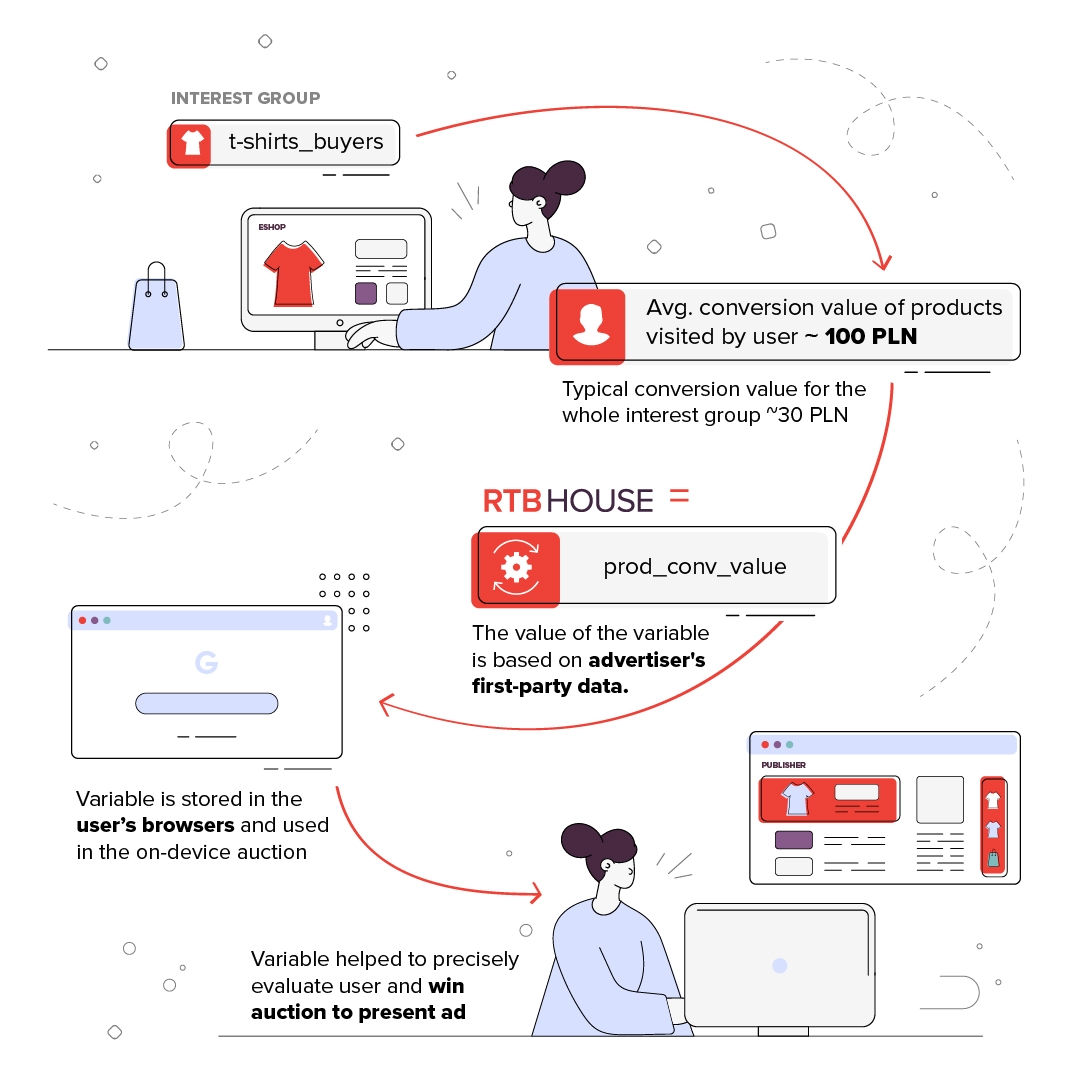Last Updated on: 2nd February 2024, 01:00 pm
We have previously presented what users will see in a cookieless future, what products will be displayed, and the end results—the visible consequences of the proposed changes to third-party cookies.
In this article, we would like to focus on what is happening behind the scenes.
In this article, you will learn the answers to:
- What are some of the advantages and challenges in terms of advertising budget allocation?
- Does the elimination of 3rd party cookies affect accurate valuations?
- What is the solution for the challenges ahead in a cookieless future
- Is it possible to maintain the current efficiency of advertising budget allocation when user data security is significantly improved?
Table of Contents:
- What is an advertising budget allocation, and why is it important?
- How to determine the right advertising budget allocation and monitor it
- Advantages & challenges of setting an ad budget allocation
- Accurate valuations and advertising budget allocation in the cookieless future
- What is Outcome-based TURTLEDOVE’s role in the Protected Audience API?
- Wrapping up
What is an advertising budget allocation, and why is it important?
Advertising budget allocation refers to the process of distributing and assigning financial resources to various advertising channels, campaigns, or initiatives within a marketing plan. In marketing, it’s about deciding where to allocate your ad dollars to get the best results. Think of it as a cake where the slices represent your goals, audience, and what worked in the past.
If your crowd hangs out on social media, a bigger slice goes to platforms like Facebook or Instagram. If you’re in a seasonal business, you might increase your budget during peak times. Checking out what your competitors are up to is like peeking at their slices’ size and distribution—it helps you stay ahead. Ultimately, smart budget allocation means keeping an eye on the big picture while fine-tuning as you go, making sure every dollar contributes to the success of your marketing plan.
Advertising budget allocation plays a pivotal role in campaign success. By allocating funds to the most effective channels, you tailor your approach to reach your target audience efficiently. This methodical distribution ensures that every dollar spent contributes meaningfully to the overall marketing objectives. In essence, advertising budget allocation is the architect’s blueprint that ensures your marketing efforts are not only well-funded, but also precisely directed for maximum impact.
How to determine the right advertising budget allocation and monitor it
Determining the right ad budget allocation involves a strategic approach grounded in a clear understanding of your business goals and audience. Start by defining your overall marketing objectives—whether it’s brand awareness, lead generation, or sales growth. Know your audience and where they’re most active, whether it’s on social media, search engines, or elsewhere. Consider the historical performance of different channels and adjust your allocation based on what has worked in the past. Keep an eye on your competition to understand industry benchmarks.
Testing and optimizing your approach is crucial—allocate a portion of your budget for experimentation and refine your strategy based on real-time performance data. Flexibility is key; be prepared to adjust allocations as market dynamics and campaign results unfold, ensuring that your ad budget aligns with your evolving business needs.
Monitoring ad budget allocation is a crucial aspect of ensuring your marketing strategy stays on track. Here’s what you can do to make sure your campaign is performing at peak efficiency:
- Regularly review the performance of each advertising channel to gauge its effectiveness.
- Utilize analytics tools to track key metrics such as impressions, clicks, and conversion rates.
- Compare the actual results with the allocated budget for each channel to identify any discrepancies.
- Keep an eye on emerging trends and shifts in consumer behavior that might impact the performance of your chosen platforms.
- Implement a systematic reporting system to provide insights into the return on investment for each channel.
- Track daily, weekly, or monthly percentage changes and assess differences between corresponding days (e.g., Monday to Monday) to easily identify and address significant fluctuations.
By consistently monitoring ad budget allocation, you can make informed decisions, reallocate resources if necessary, and optimize your marketing strategy for ongoing success.
Advantages & challenges of setting an ad budget allocation
In the realm of marketing, ad budget allocation acts as a compass, guiding businesses toward success. Let’s take a closer look at the advantages of ad budget allocation, where strategic decisions pave the way for impactful marketing endeavors:
- Strategic focus: Ad budget allocation allows businesses to strategically focus their resources on the most effective advertising channels, ensuring a targeted and impactful approach.
- Optimized resource utilization: By distributing the budget based on the historical performance and current effectiveness of different channels, companies can optimize the use of their resources for maximum ROI.
- Flexibility and adaptability: Allocating budgets provides flexibility to adapt to changing market dynamics. Businesses can adjust allocations in real-time based on campaign performance, industry trends, or shifts in consumer behavior.
- Goal alignment: Setting ad budget allocation aligns advertising efforts with overall marketing goals, whether it’s increasing brand awareness, driving website traffic, or boosting sales.
- Competitive advantage: Monitoring competitors’ strategies and allocating budgets accordingly helps maintain a competitive edge, ensuring that your business becomes visible where your competitors aren’t.
Navigating the dynamic landscape of marketing isn’t all smooth sailing. Just as every journey encounters rough seas, the process of ad budget allocation brings forth its own set of challenges:
- Data accuracy: Dependence on accurate data is crucial for effective budget allocation. Inaccurate or incomplete data can lead to suboptimal decisions and hinder the success of advertising campaigns.
- Changing trends: Consumer behavior and advertising trends can evolve rapidly. Adapting to these changes requires constant monitoring and adjustment, posing a challenge for businesses trying to stay ahead.
- Budget constraints: Limited budgets may restrict the ability to allocate funds to various channels adequately. This challenge requires careful prioritization and creative solutions to achieve optimal results within financial constraints.
- Platform complexity: Managing multiple advertising platforms can be complex. Each platform comes with its own set of tools, metrics, and algorithms, making it challenging to allocate budgets effectively without a deep understanding of each.
- Uncertain returns: Predicting the exact returns on investment for each channel can be challenging. Businesses may face uncertainties regarding the actual impact of their budget allocations on key performance indicators.
Addressing these challenges requires a balanced and data-driven approach, where businesses continuously assess their advertising strategies, stay informed about industry trends, and remain agile in adapting their budget allocations to align with evolving marketing landscapes.
Accurate valuations and advertising budget allocation in the cookieless future
At RTB House, we use powerful algorithms to find the right user at the right time to display an ad at an optimal price to distribute the customer advertising budgets effectively. These algorithms are fed a lot of data, especially for impression valuation. The more information we deliver to the bidder—the more willing the bidder will be to buy.
Ultimately, the idea is to match the price that is paid for the impression to the likelihood of the purchasing parameters of the user. Today’s algorithms can accurately estimate this parameter and specify the price accordingly, which assists with keeping an advertising budget allocation in line.
By default, an impression served to a person clicking on many products, adding them to the basket, and frequently returning to the website is more expensive than the casual visitor. Such a pattern should be adequately mirrored in the page view price.
All the changes resulting from a cookieless future and the difference in the approach to targeting individuals as opposed to using third-party cookies appear to limit the possibilities of an accurate valuation. The apparent necessity of group valuations could leave several inaccuracies as compared to individual valuations.
The inaccuracy of impression valuations, especially in the context of first-price auctions, would increase the ineffectiveness of advertising budget allocations. A valuation that is too low would result in the inability to buy an impression, while a valuation that is too high would cause suboptimal budget spend.
RTB House’s Outcome-based TURTLEDOVE (OBTD), which is included in Protected Audience API (PAAPI), is the direct answer to these potential challenges.
What is Outcome-based TURTLEDOVE’s role in the Protected Audience API?
The main idea of Outcome-based TURTLEDOVE (OBTD) is to separate the mechanism of impression price valuation for a given user from the means of microtargeting prevention. As the authors of this proposal, we would like to show you how it works.
Thanks to OBTD, when a user visits the advertisers’ website, PAAPI can save additional information in the user’s browser as part of the so-called UserSignals. This data will be stored directly on the user’s device and will not be accessible to external companies.
The diagram below is designed to help you understand the process and show you how helpful this information can be for PAAPI:

= On the advertiser’s website, the user is added to an interest group: “t-shirts_buyers”
= Visits only premium t-shirts with an average conversion value of 100 PLN vs. just 30 PLN for the whole category.
How to improve the accuracy of this valuation compared to other members of the interest group for the auction?
= RTB House sends what the value of the “prod_conv_value” variable should be for this user based on first-party data from the advertiser.
= We define the bidding function for the whole interest group, for example:
BID = 0.01 * prod_conv_value.
= The variable, stored in the user’s browser, is then used in the on-device auction for displaying an ad on the publisher’s website while keeping everything privacy-friendly.
OBTD unlocked a wide range of precise signals to be used for bidding, which is crucial for bidding accuracy.
See also: Cookieless Retargeting—How Will It Work?
Wrapping up
Since the industry needs to maintain the accuracy of valuations at current levels, RTB House has proposed a solution that makes this possible for Protected Audience API while protecting the identity of individual users.
The separation of the microtargeting prevention mechanism from the bidding mechanism allows for a flexibility increase—it can be adjusted without modifying the bidding module.
In addition, we have developed a proof of concept ad validation algorithm and analyzed its microtargeting prevention aspects. We carried out an extensive analysis and proved that the current separate mechanisms meet the highest mathematical guarantees of privacy and security.
If you have any questions or comments regarding the article, please let us know.





